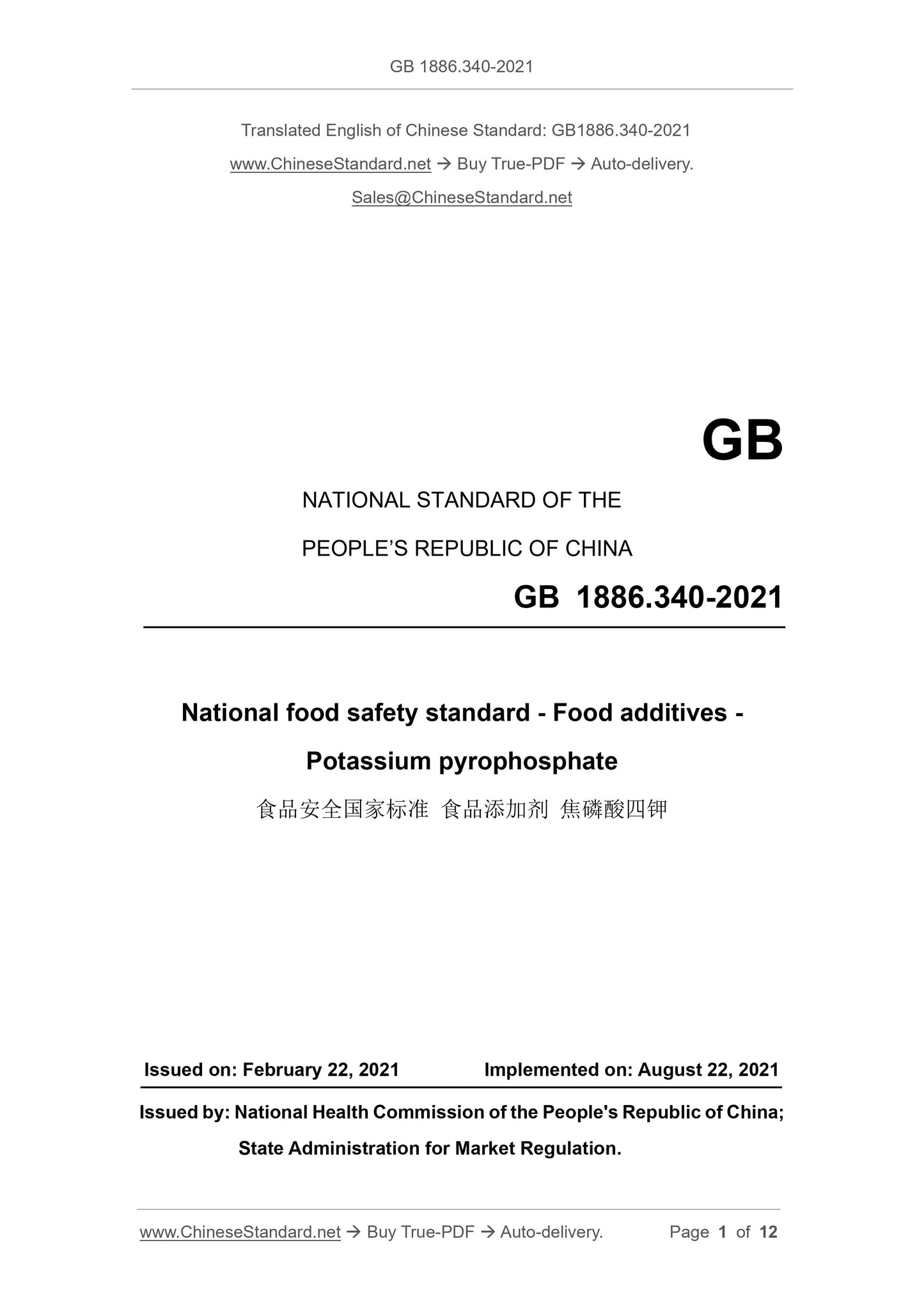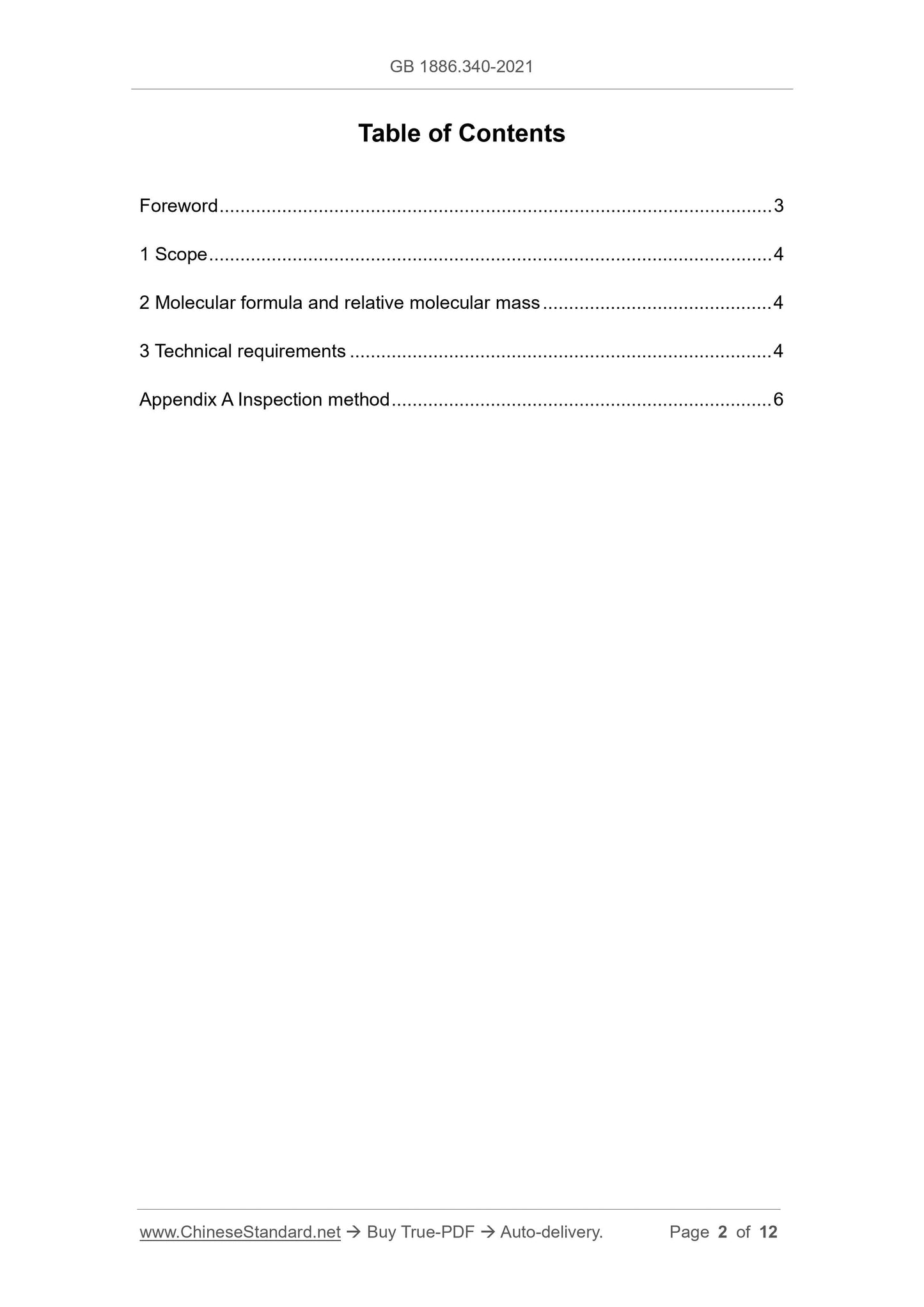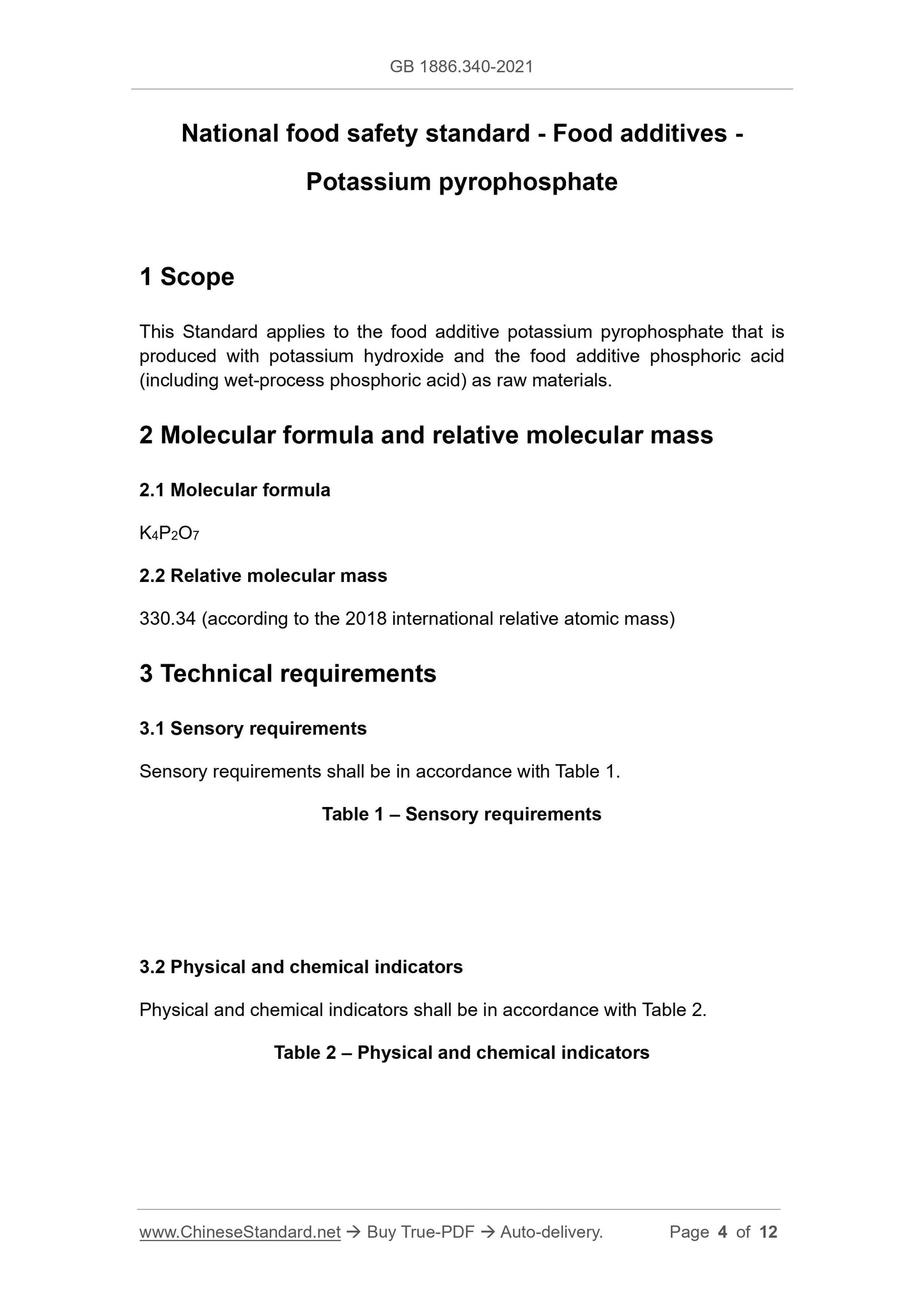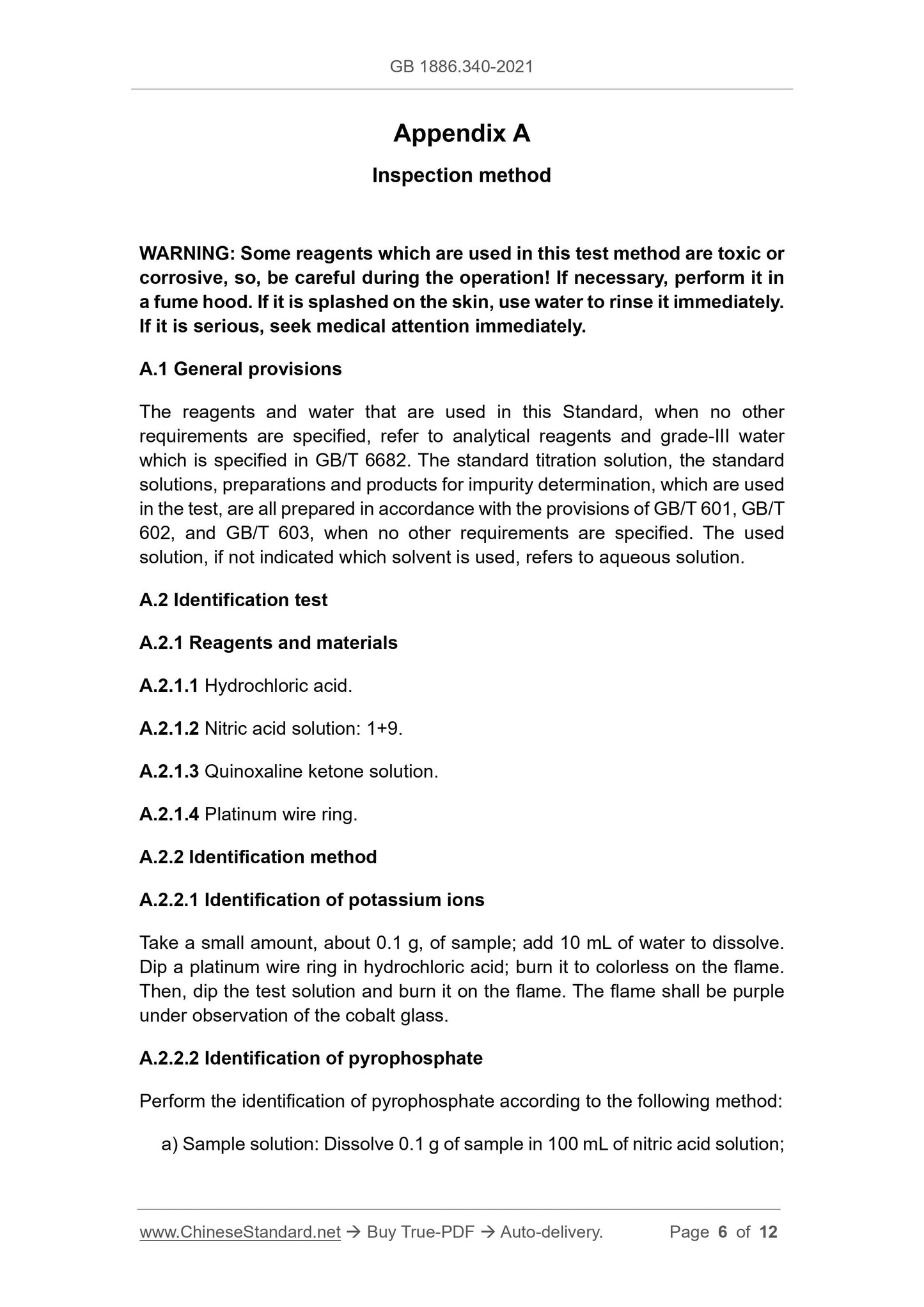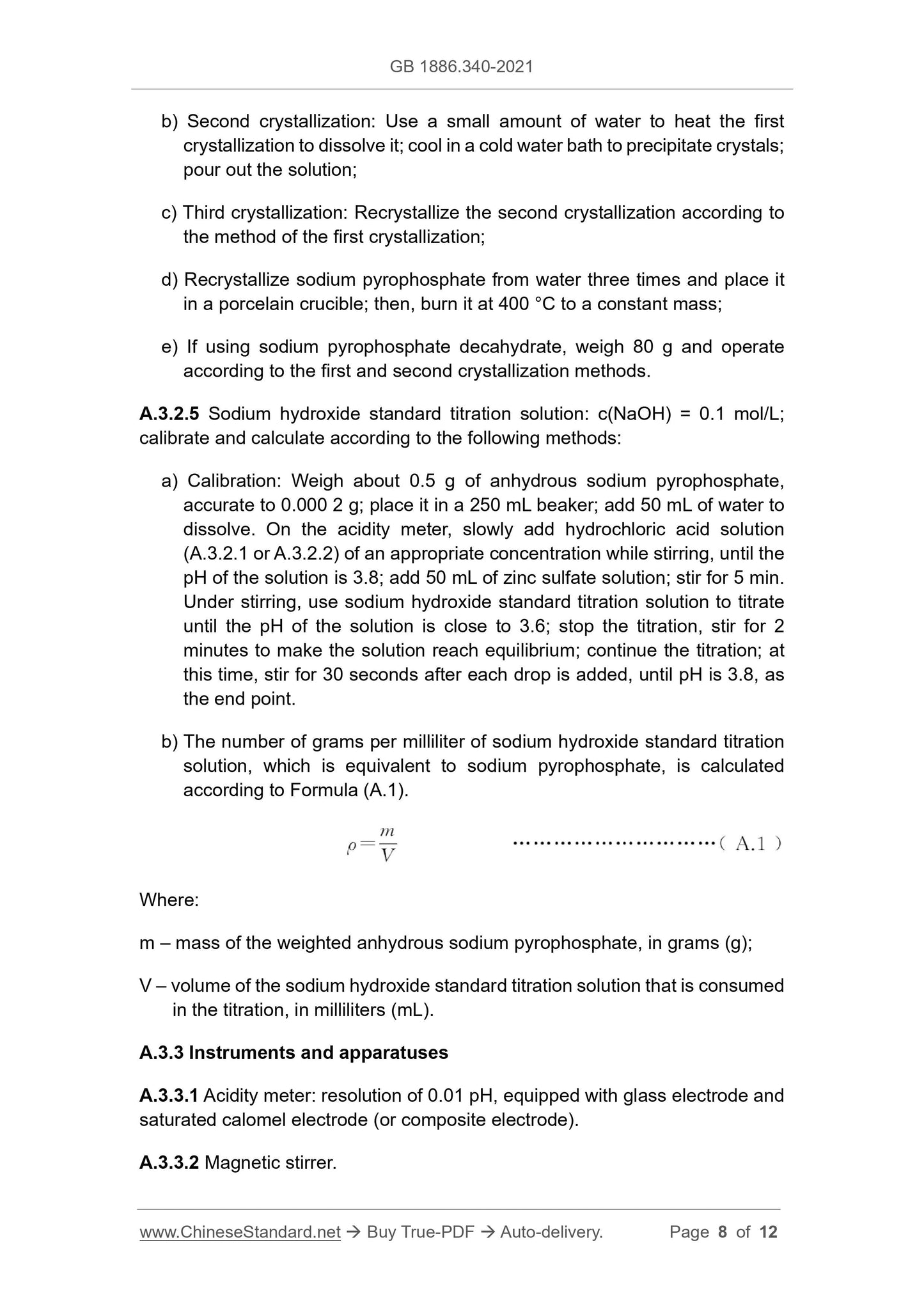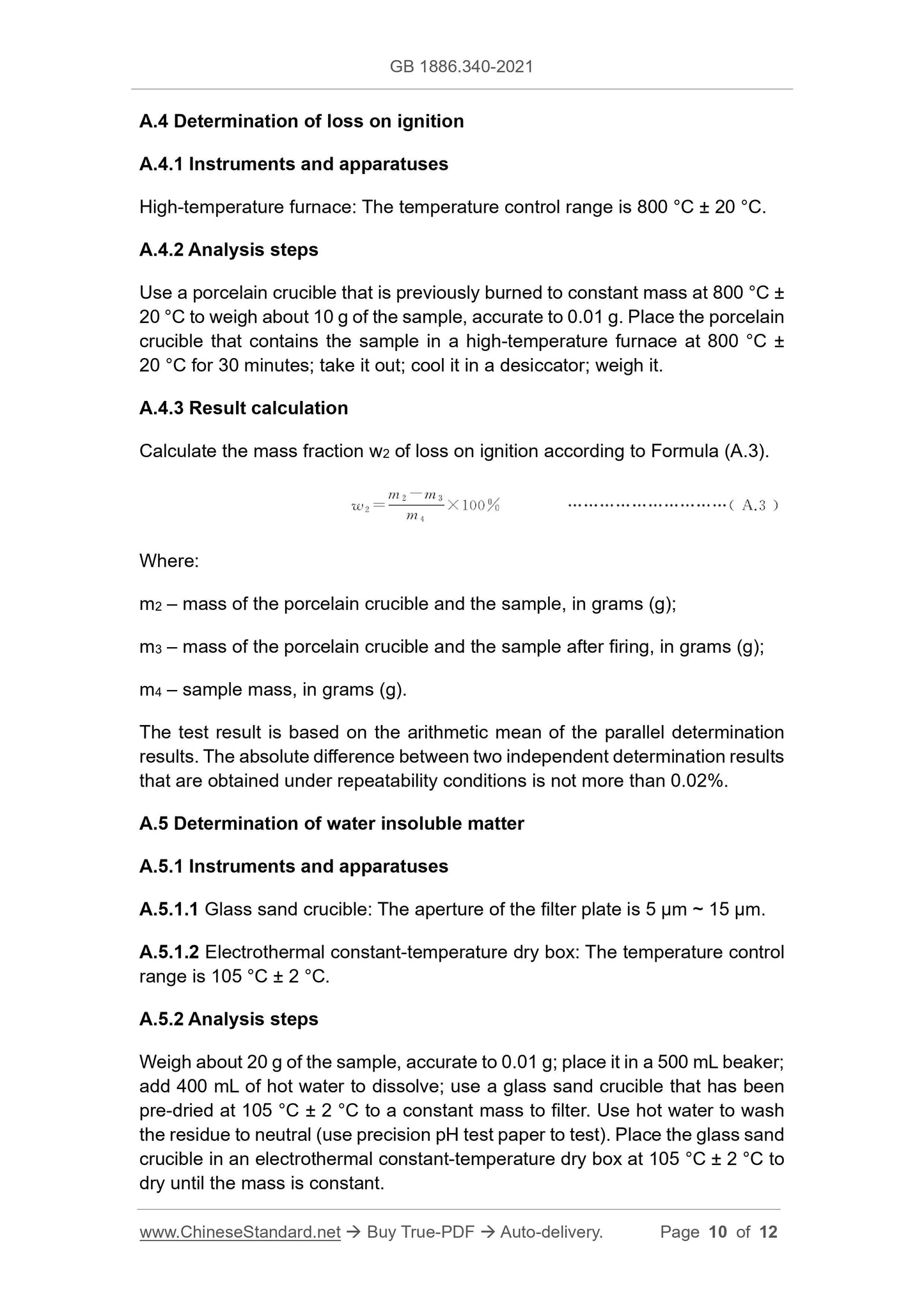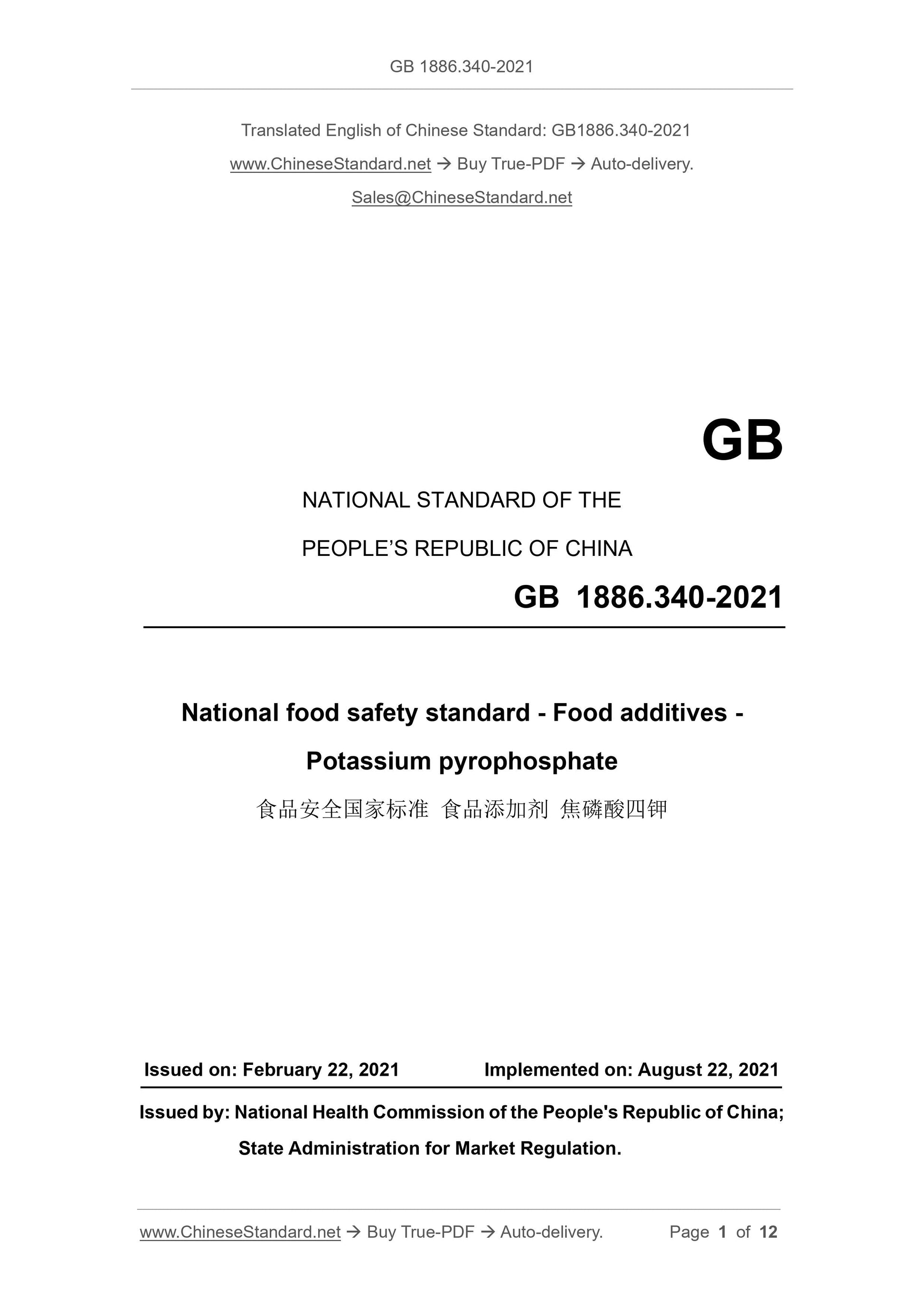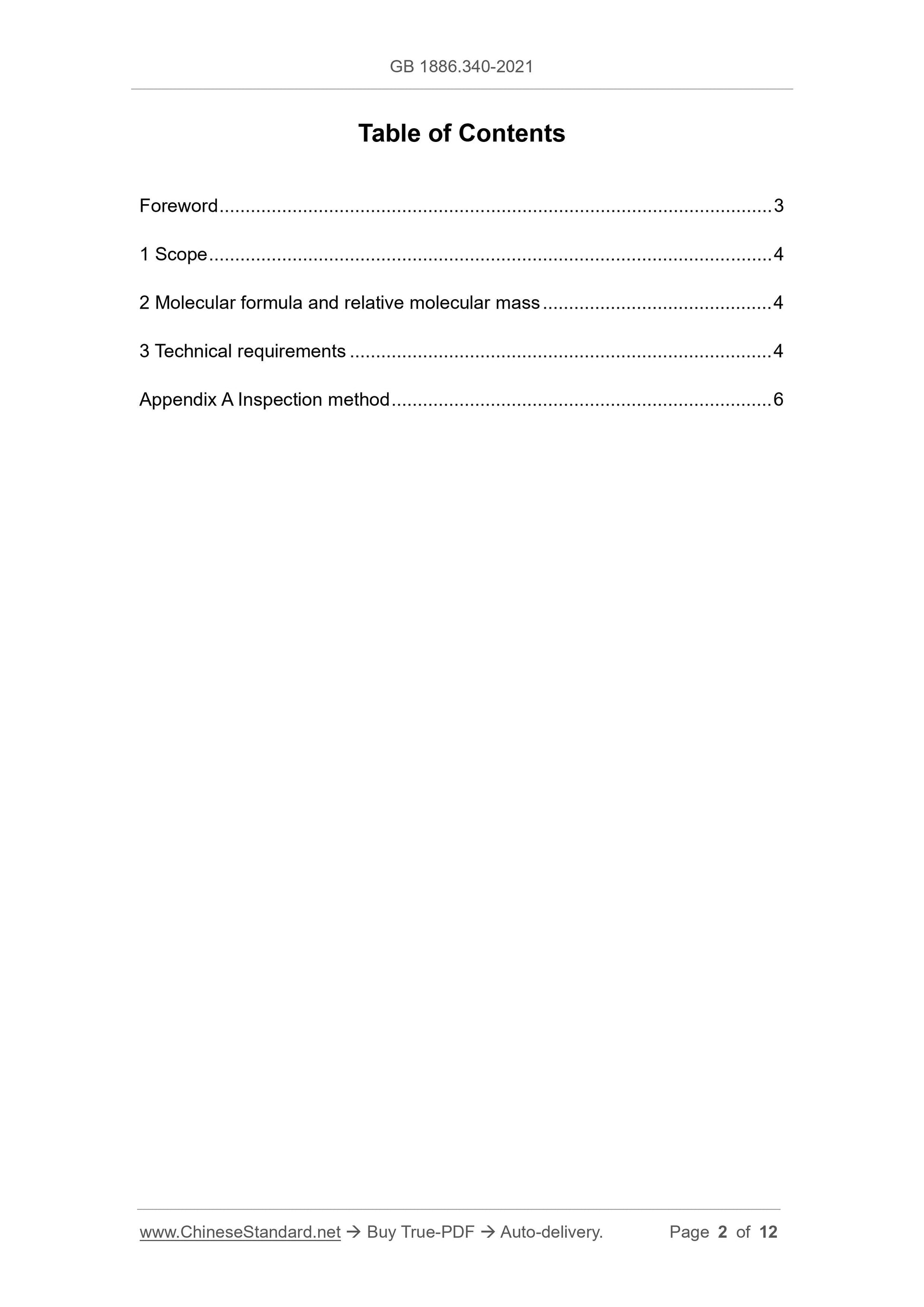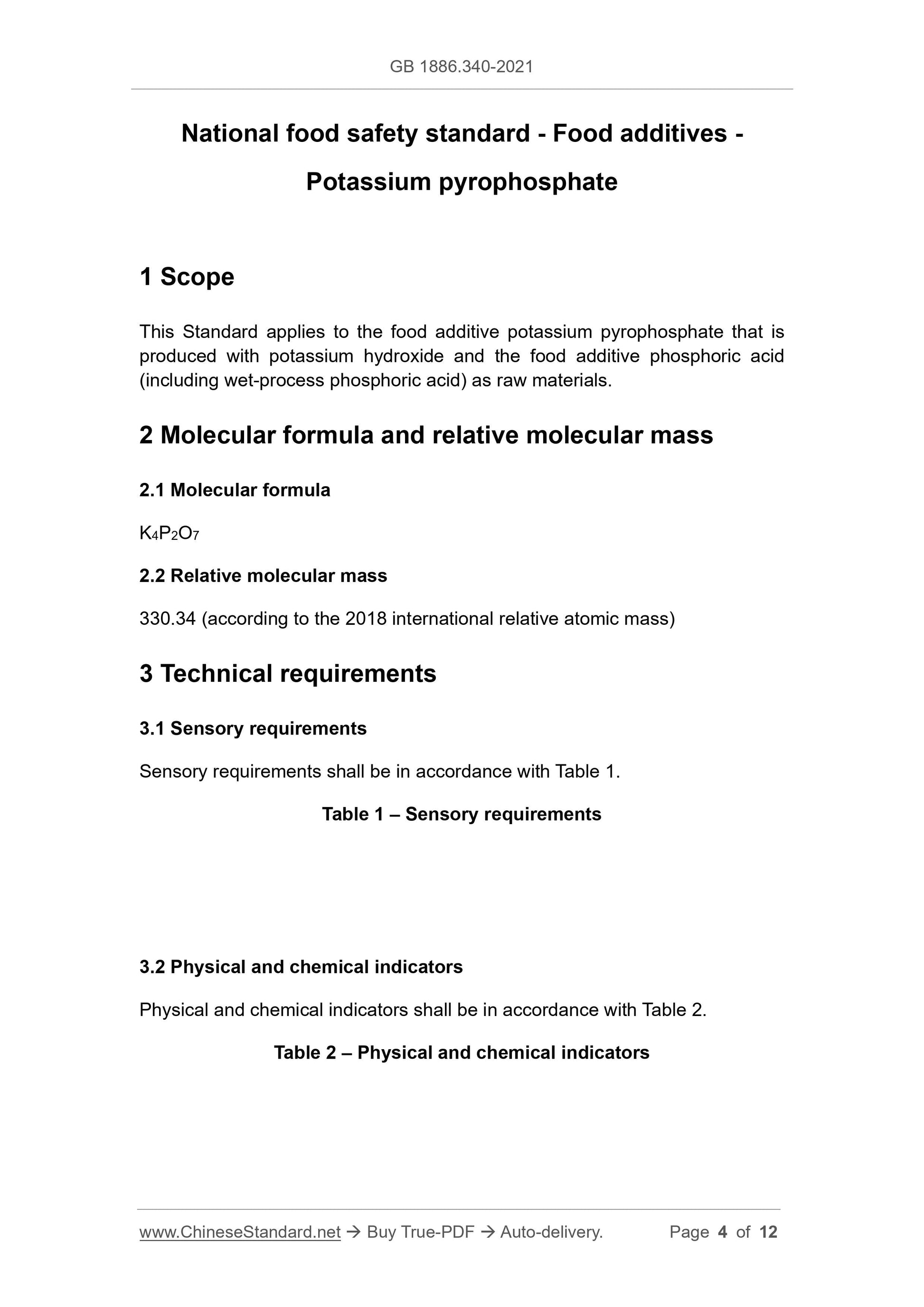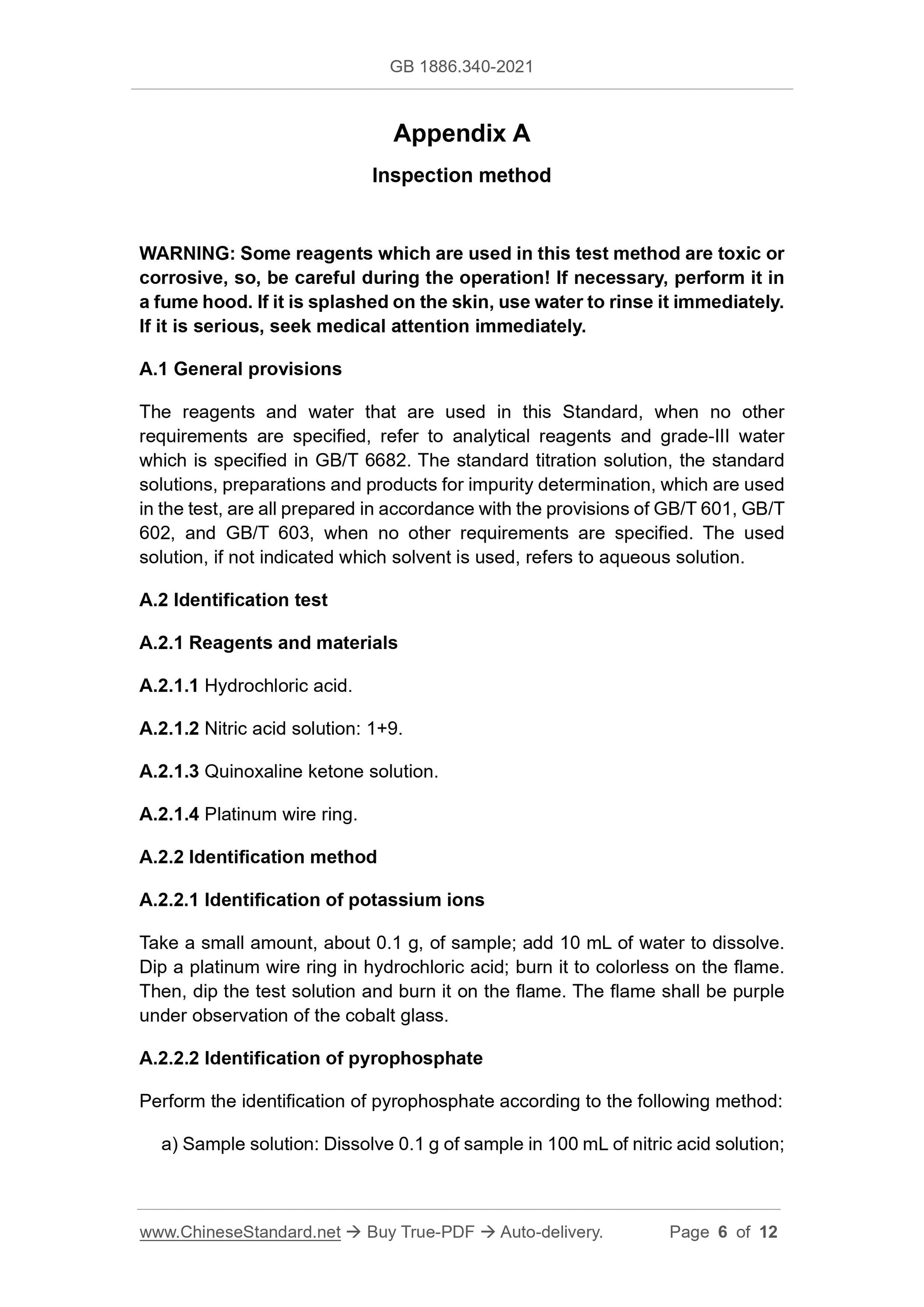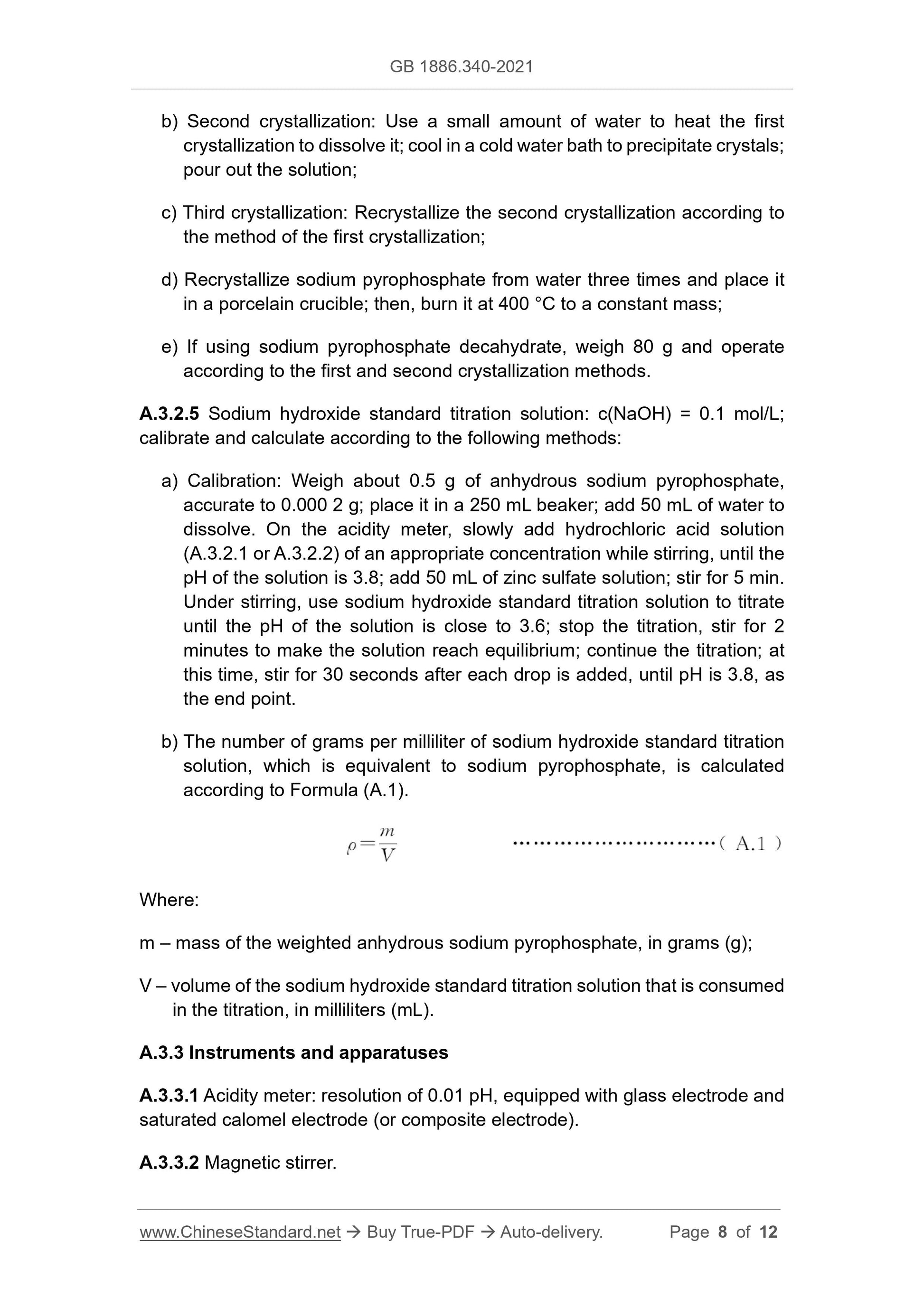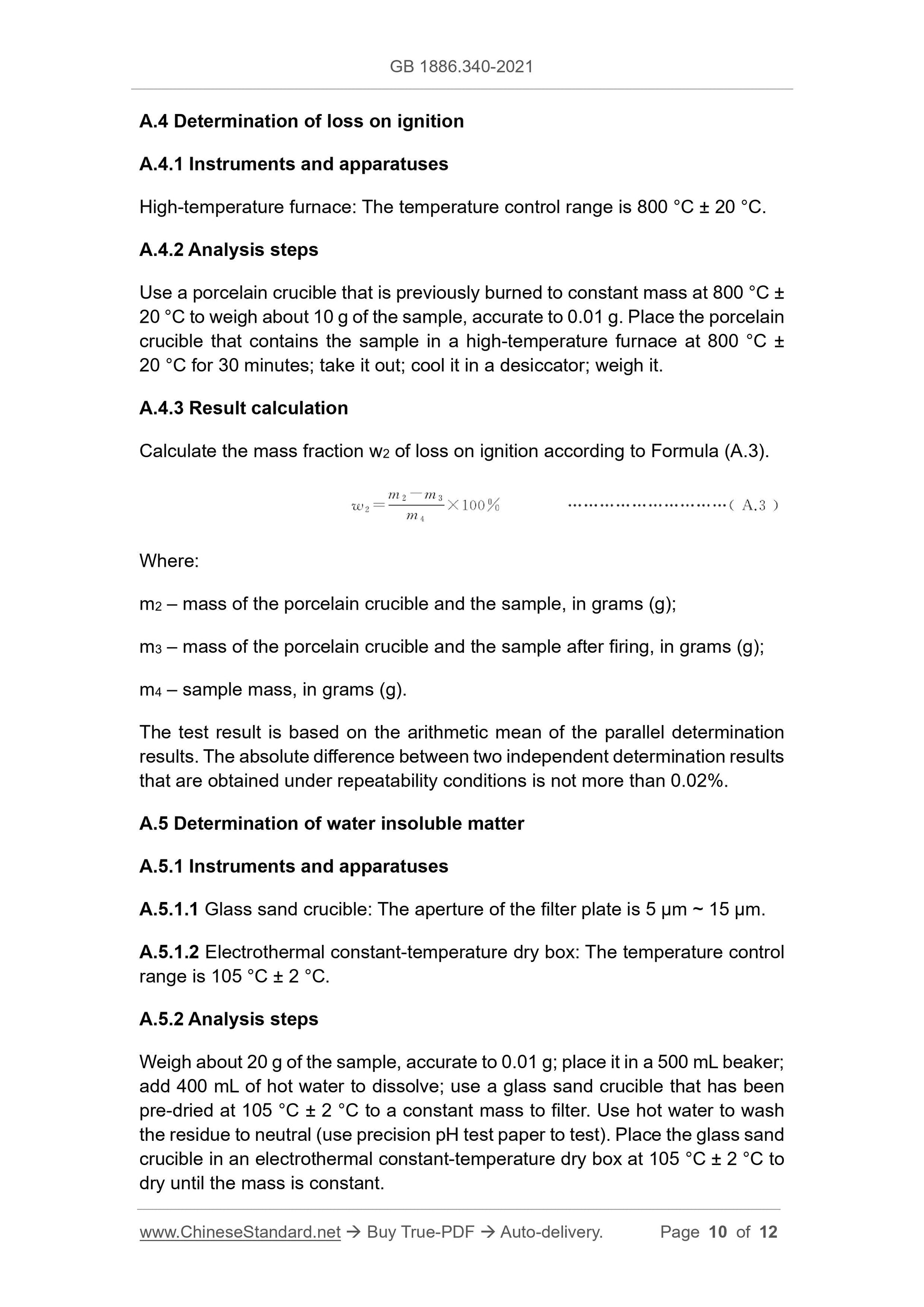1
/
of
6
www.ChineseStandard.us -- Field Test Asia Pte. Ltd.
GB 1886.340-2021 English PDF
GB 1886.340-2021 English PDF
Regular price
$95.00
Regular price
Sale price
$95.00
Unit price
/
per
Shipping calculated at checkout.
Couldn't load pickup availability
GB 1886.340-2021: National food safety standard - Food additives - Potassium pyrophosphate
Delivery: 9 seconds. Download (& Email) true-PDF + Invoice.
Get Quotation: Click GB 1886.340-2021 (Self-service in 1-minute)
Historical versions (Master-website): GB 1886.340-2021
Preview True-PDF (Reload/Scroll-down if blank)
GB 1886.340-2021
GB
NATIONAL STANDARD OF THE
PEOPLE’S REPUBLIC OF CHINA
National food safety standard - Food additives -
Potassium pyrophosphate
ISSUED ON: FEBRUARY 22, 2021
IMPLEMENTED ON: AUGUST 22, 2021
Issued by: National Health Commission of the People's Republic of China;
State Administration for Market Regulation.
Table of Contents
Foreword ... 3
1 Scope ... 4
2 Molecular formula and relative molecular mass ... 4
3 Technical requirements ... 4
Appendix A Inspection method ... 6
National food safety standard - Food additives -
Potassium pyrophosphate
1 Scope
This Standard applies to the food additive potassium pyrophosphate that is
produced with potassium hydroxide and the food additive phosphoric acid
(including wet-process phosphoric acid) as raw materials.
2 Molecular formula and relative molecular mass
2.1 Molecular formula
K4P2O7
2.2 Relative molecular mass
330.34 (according to the 2018 international relative atomic mass)
3 Technical requirements
3.1 Sensory requirements
Sensory requirements shall be in accordance with Table 1.
Table 1 – Sensory requirements
3.2 Physical and chemical indicators
Physical and chemical indicators shall be in accordance with Table 2.
Table 2 – Physical and chemical indicators
Appendix A
Inspection method
WARNING: Some reagents which are used in this test method are toxic or
corrosive, so, be careful during the operation! If necessary, perform it in
a fume hood. If it is splashed on the skin, use water to rinse it immediately.
If it is serious, seek medical attention immediately.
A.1 General provisions
The reagents and water that are used in this Standard, when no other
requirements are specified, refer to analytical reagents and grade-III water
which is specified in GB/T 6682. The standard titration solution, the standard
solutions, preparations and products for impurity determination, which are used
in the test, are all prepared in accordance with the provisions of GB/T 601, GB/T
602, and GB/T 603, when no other requirements are specified. The used
solution, if not indicated which solvent is used, refers to aqueous solution.
A.2 Identification test
A.2.1 Reagents and materials
A.2.1.1 Hydrochloric acid.
A.2.1.2 Nitric acid solution: 1+9.
A.2.1.3 Quinoxaline ketone solution.
A.2.1.4 Platinum wire ring.
A.2.2 Identification method
A.2.2.1 Identification of potassium ions
Take a small amount, about 0.1 g, of sample; add 10 mL of water to dissolve.
Dip a platinum wire ring in hydrochloric acid; burn it to colorless on the flame.
Then, dip the test solution and burn it on the flame. The flame shall be purple
under observation of the cobalt glass.
A.2.2.2 Identification of pyrophosphate
Perform the identification of pyrophosphate according to the following method:
a) Sample solution: Dissolve 0.1 g of sample in 100 mL of nitric acid solution;
b) Second crystallization: Use a small amount of water to heat the first
crystallization to dissolve it; cool in a cold water bath to precipitate crystals;
pour out the solution;
c) Third crystallization: Recrystallize the second crystallization according to
the method of the first crystallization;
d) Recrystallize sodium pyrophosphate from water three times and place it
in a porcelain crucible; then, burn it at 400 °C to a constant mass;
e) If using sodium pyrophosphate decahydrate, weigh 80 g and operate
according to the first and second crystallization methods.
A.3.2.5 Sodium hydroxide standard titration solution: c(NaOH) = 0.1 mol/L;
calibrate and calculate according to the following methods:
a) Calibration: Weigh about 0.5 g of anhydrous sodium pyrophosphate,
accurate to 0.000 2 g; place it in a 250 mL beaker; add 50 mL of water to
dissolve. On the acidity meter, slowly add hydrochloric acid solution
(A.3.2.1 or A.3.2.2) of an appropriate concentration while stirring, until the
pH of the solution is 3.8; add 50 mL of zinc sulfate solution; stir for 5 min.
Under stirring, use sodium hydroxide standard titration solution to titrate
until the pH of the solution is close to 3.6; stop the titration, stir for 2
minutes to make the solution reach equilibrium; continue the titration; at
this time, stir for 30 seconds after each drop is added, until pH is 3.8, as
the end point.
b) The number of grams per milliliter of sodium hydroxide standard titration
solution, which is equivalent to sodium pyrophosphate, is calculated
according to Formula (A.1).
Where:
m – mass of the weighted anhydrous sodium pyrophosphate, in grams (g);
V – volume of the sodium hydroxide standard titration solution that is consumed
in the titration, in milliliters (mL).
A.3.3 Instruments and apparatuses
A.3.3.1 Acidity meter: resolution of 0.01 pH, equipped with glass electrode and
saturated calomel electrode (or composite electrode).
A.3.3.2 Magnetic stirrer.
A.4 Determination of loss on ignition
A.4.1 Instruments and apparatuses
High-temperature furnace: The temperature control range is 800 °C ± 20 °C.
A.4.2 Analysis steps
Use a porcelain crucible that is previously burned to constant mass at 800 °C ±
20 °C to weigh about 10 g of the sample, accurate to 0.01 g. Place the porcelain
crucible that contains the sample in a high-temperature furnace at 800 °C ±
20 °C for 30 minutes; take it out; cool it in a desiccator; weigh it.
A.4.3 Result calculation
Calculate the mass fraction w2 of loss on ignition according to Formula (A.3).
Where:
m2 – mass of the porcelain crucible and the sample, in grams (g);
m3 – mass of the porcelain crucible and the sample after firing, in grams (g);
m4 – sample mass, in grams (g).
The test result is based on the arithmetic mean of the parallel determination
results. The absolute difference between two independent determination results
that are obtained under repeatability conditions is not more than 0.02%.
A.5 Determination of water insoluble matter
A.5.1 Instruments and apparatuses
A.5.1.1 Glass sand crucible: The aperture of the filter plate is 5 μm ~ 15 μm.
A.5.1.2 Electrothermal constant-temperature dry box: The temperature control
range is 105 °C ± 2 °C.
A.5.2 Analysis steps
Weigh about 20 g of the sample, accurate to 0.01 g; place it in a 500 mL beaker;
add 400 mL of hot water to dissolve; use a glass sand crucible that has been
pre-dried at 105 °C ± 2 °C to a constant mass to filter. Use hot water to wash
the residue to neutral (use precision pH test paper to test). Place the glass sand
crucible in an electrothermal constant-temperature dry box at 105 °C ± 2 °C to
dry until the mass is constant.
GB 1886.340-2021
GB
NATIONAL STANDARD OF THE
PEOPLE’S REPUBLIC OF CHINA
National food safety standard - Food additives -
Potassium pyrophosphate
ISSUED ON: FEBRUARY 22, 2021
IMPLEMENTED ON: AUGUST 22, 2021
Issued by: National Health Commission of the People's Republic of China;
State Administration for Market Regulation.
Table of Contents
Foreword ... 3
1 Scope ... 4
2 Molecular formula and relative molecular mass ... 4
3 Technical requirements ... 4
Appendix A Inspection method ... 6
National food safety standard - Food additives -
Potassium pyrophosphate
1 Scope
This Standard applies to the food additive potassium pyrophosphate that is
produced with potassium hydroxide and the food additive phosphoric acid
(including wet-process phosphoric acid) as raw materials.
2 Molecular formula and relative molecular mass
2.1 Molecular formula
K4P2O7
2.2 Relative molecular mass
330.34 (according to the 2018 international relative atomic mass)
3 Technical requirements
3.1 Sensory requirements
Sensory requirements shall be in accordance with Table 1.
Table 1 – Sensory requirements
3.2 Physical and chemical indicators
Physical and chemical indicators shall be in accordance with Table 2.
Table 2 – Physical and chemical indicators
Appendix A
Inspection method
WARNING: Some reagents which are used in this test method are toxic or
corrosive, so, be careful during the operation! If necessary, perform it in
a fume hood. If it is splashed on the skin, use water to rinse it immediately.
If it is serious, seek medical attention immediately.
A.1 General provisions
The reagents and water that are used in this Standard, when no other
requirements are specified, refer to analytical reagents and grade-III water
which is specified in GB/T 6682. The standard titration solution, the standard
solutions, preparations and products for impurity determination, which are used
in the test, are all prepared in accordance with the provisions of GB/T 601, GB/T
602, and GB/T 603, when no other requirements are specified. The used
solution, if not indicated which solvent is used, refers to aqueous solution.
A.2 Identification test
A.2.1 Reagents and materials
A.2.1.1 Hydrochloric acid.
A.2.1.2 Nitric acid solution: 1+9.
A.2.1.3 Quinoxaline ketone solution.
A.2.1.4 Platinum wire ring.
A.2.2 Identification method
A.2.2.1 Identification of potassium ions
Take a small amount, about 0.1 g, of sample; add 10 mL of water to dissolve.
Dip a platinum wire ring in hydrochloric acid; burn it to colorless on the flame.
Then, dip the test solution and burn it on the flame. The flame shall be purple
under observation of the cobalt glass.
A.2.2.2 Identification of pyrophosphate
Perform the identification of pyrophosphate according to the following method:
a) Sample solution: Dissolve 0.1 g of sample in 100 mL of nitric acid solution;
b) Second crystallization: Use a small amount of water to heat the first
crystallization to dissolve it; cool in a cold water bath to precipitate crystals;
pour out the solution;
c) Third crystallization: Recrystallize the second crystallization according to
the method of the first crystallization;
d) Recrystallize sodium pyrophosphate from water three times and place it
in a porcelain crucible; then, burn it at 400 °C to a constant mass;
e) If using sodium pyrophosphate decahydrate, weigh 80 g and operate
according to the first and second crystallization methods.
A.3.2.5 Sodium hydroxide standard titration solution: c(NaOH) = 0.1 mol/L;
calibrate and calculate according to the following methods:
a) Calibration: Weigh about 0.5 g of anhydrous sodium pyrophosphate,
accurate to 0.000 2 g; place it in a 250 mL beaker; add 50 mL of water to
dissolve. On the acidity meter, slowly add hydrochloric acid solution
(A.3.2.1 or A.3.2.2) of an appropriate concentration while stirring, until the
pH of the solution is 3.8; add 50 mL of zinc sulfate solution; stir for 5 min.
Under stirring, use sodium hydroxide standard titration solution to titrate
until the pH of the solution is close to 3.6; stop the titration, stir for 2
minutes to make the solution reach equilibrium; continue the titration; at
this time, stir for 30 seconds after each drop is added, until pH is 3.8, as
the end point.
b) The number of grams per milliliter of sodium hydroxide standard titration
solution, which is equivalent to sodium pyrophosphate, is calculated
according to Formula (A.1).
Where:
m – mass of the weighted anhydrous sodium pyrophosphate, in grams (g);
V – volume of the sodium hydroxide standard titration solution that is consumed
in the titration, in milliliters (mL).
A.3.3 Instruments and apparatuses
A.3.3.1 Acidity meter: resolution of 0.01 pH, equipped with glass electrode and
saturated calomel electrode (or composite electrode).
A.3.3.2 Magnetic stirrer.
A.4 Determination of loss on ignition
A.4.1 Instruments and apparatuses
High-temperature furnace: The temperature control range is 800 °C ± 20 °C.
A.4.2 Analysis steps
Use a porcelain crucible that is previously burned to constant mass at 800 °C ±
20 °C to weigh about 10 g of the sample, accurate to 0.01 g. Place the porcelain
crucible that contains the sample in a high-temperature furnace at 800 °C ±
20 °C for 30 minutes; take it out; cool it in a desiccator; weigh it.
A.4.3 Result calculation
Calculate the mass fraction w2 of loss on ignition according to Formula (A.3).
Where:
m2 – mass of the porcelain crucible and the sample, in grams (g);
m3 – mass of the porcelain crucible and the sample after firing, in grams (g);
m4 – sample mass, in grams (g).
The test result is based on the arithmetic mean of the parallel determination
results. The absolute difference between two independent determination results
that are obtained under repeatability conditions is not more than 0.02%.
A.5 Determination of water insoluble matter
A.5.1 Instruments and apparatuses
A.5.1.1 Glass sand crucible: The aperture of the filter plate is 5 μm ~ 15 μm.
A.5.1.2 Electrothermal constant-temperature dry box: The temperature control
range is 105 °C ± 2 °C.
A.5.2 Analysis steps
Weigh about 20 g of the sample, accurate to 0.01 g; place it in a 500 mL beaker;
add 400 mL of hot water to dissolve; use a glass sand crucible that has been
pre-dried at 105 °C ± 2 °C to a constant mass to filter. Use hot water to wash
the residue to neutral (use precision pH test paper to test). Place the glass sand
crucible in an electrothermal constant-temperature dry box at 105 °C ± 2 °C to
dry until the mass is constant.
Delivery: 9 seconds. Download (& Email) true-PDF + Invoice.
Get Quotation: Click GB 1886.340-2021 (Self-service in 1-minute)
Historical versions (Master-website): GB 1886.340-2021
Preview True-PDF (Reload/Scroll-down if blank)
GB 1886.340-2021
GB
NATIONAL STANDARD OF THE
PEOPLE’S REPUBLIC OF CHINA
National food safety standard - Food additives -
Potassium pyrophosphate
ISSUED ON: FEBRUARY 22, 2021
IMPLEMENTED ON: AUGUST 22, 2021
Issued by: National Health Commission of the People's Republic of China;
State Administration for Market Regulation.
Table of Contents
Foreword ... 3
1 Scope ... 4
2 Molecular formula and relative molecular mass ... 4
3 Technical requirements ... 4
Appendix A Inspection method ... 6
National food safety standard - Food additives -
Potassium pyrophosphate
1 Scope
This Standard applies to the food additive potassium pyrophosphate that is
produced with potassium hydroxide and the food additive phosphoric acid
(including wet-process phosphoric acid) as raw materials.
2 Molecular formula and relative molecular mass
2.1 Molecular formula
K4P2O7
2.2 Relative molecular mass
330.34 (according to the 2018 international relative atomic mass)
3 Technical requirements
3.1 Sensory requirements
Sensory requirements shall be in accordance with Table 1.
Table 1 – Sensory requirements
3.2 Physical and chemical indicators
Physical and chemical indicators shall be in accordance with Table 2.
Table 2 – Physical and chemical indicators
Appendix A
Inspection method
WARNING: Some reagents which are used in this test method are toxic or
corrosive, so, be careful during the operation! If necessary, perform it in
a fume hood. If it is splashed on the skin, use water to rinse it immediately.
If it is serious, seek medical attention immediately.
A.1 General provisions
The reagents and water that are used in this Standard, when no other
requirements are specified, refer to analytical reagents and grade-III water
which is specified in GB/T 6682. The standard titration solution, the standard
solutions, preparations and products for impurity determination, which are used
in the test, are all prepared in accordance with the provisions of GB/T 601, GB/T
602, and GB/T 603, when no other requirements are specified. The used
solution, if not indicated which solvent is used, refers to aqueous solution.
A.2 Identification test
A.2.1 Reagents and materials
A.2.1.1 Hydrochloric acid.
A.2.1.2 Nitric acid solution: 1+9.
A.2.1.3 Quinoxaline ketone solution.
A.2.1.4 Platinum wire ring.
A.2.2 Identification method
A.2.2.1 Identification of potassium ions
Take a small amount, about 0.1 g, of sample; add 10 mL of water to dissolve.
Dip a platinum wire ring in hydrochloric acid; burn it to colorless on the flame.
Then, dip the test solution and burn it on the flame. The flame shall be purple
under observation of the cobalt glass.
A.2.2.2 Identification of pyrophosphate
Perform the identification of pyrophosphate according to the following method:
a) Sample solution: Dissolve 0.1 g of sample in 100 mL of nitric acid solution;
b) Second crystallization: Use a small amount of water to heat the first
crystallization to dissolve it; cool in a cold water bath to precipitate crystals;
pour out the solution;
c) Third crystallization: Recrystallize the second crystallization according to
the method of the first crystallization;
d) Recrystallize sodium pyrophosphate from water three times and place it
in a porcelain crucible; then, burn it at 400 °C to a constant mass;
e) If using sodium pyrophosphate decahydrate, weigh 80 g and operate
according to the first and second crystallization methods.
A.3.2.5 Sodium hydroxide standard titration solution: c(NaOH) = 0.1 mol/L;
calibrate and calculate according to the following methods:
a) Calibration: Weigh about 0.5 g of anhydrous sodium pyrophosphate,
accurate to 0.000 2 g; place it in a 250 mL beaker; add 50 mL of water to
dissolve. On the acidity meter, slowly add hydrochloric acid solution
(A.3.2.1 or A.3.2.2) of an appropriate concentration while stirring, until the
pH of the solution is 3.8; add 50 mL of zinc sulfate solution; stir for 5 min.
Under stirring, use sodium hydroxide standard titration solution to titrate
until the pH of the solution is close to 3.6; stop the titration, stir for 2
minutes to make the solution reach equilibrium; continue the titration; at
this time, stir for 30 seconds after each drop is added, until pH is 3.8, as
the end point.
b) The number of grams per milliliter of sodium hydroxide standard titration
solution, which is equivalent to sodium pyrophosphate, is calculated
according to Formula (A.1).
Where:
m – mass of the weighted anhydrous sodium pyrophosphate, in grams (g);
V – volume of the sodium hydroxide standard titration solution that is consumed
in the titration, in milliliters (mL).
A.3.3 Instruments and apparatuses
A.3.3.1 Acidity meter: resolution of 0.01 pH, equipped with glass electrode and
saturated calomel electrode (or composite electrode).
A.3.3.2 Magnetic stirrer.
A.4 Determination of loss on ignition
A.4.1 Instruments and apparatuses
High-temperature furnace: The temperature control range is 800 °C ± 20 °C.
A.4.2 Analysis steps
Use a porcelain crucible that is previously burned to constant mass at 800 °C ±
20 °C to weigh about 10 g of the sample, accurate to 0.01 g. Place the porcelain
crucible that contains the sample in a high-temperature furnace at 800 °C ±
20 °C for 30 minutes; take it out; cool it in a desiccator; weigh it.
A.4.3 Result calculation
Calculate the mass fraction w2 of loss on ignition according to Formula (A.3).
Where:
m2 – mass of the porcelain crucible and the sample, in grams (g);
m3 – mass of the porcelain crucible and the sample after firing, in grams (g);
m4 – sample mass, in grams (g).
The test result is based on the arithmetic mean of the parallel determination
results. The absolute difference between two independent determination results
that are obtained under repeatability conditions is not more than 0.02%.
A.5 Determination of water insoluble matter
A.5.1 Instruments and apparatuses
A.5.1.1 Glass sand crucible: The aperture of the filter plate is 5 μm ~ 15 μm.
A.5.1.2 Electrothermal constant-temperature dry box: The temperature control
range is 105 °C ± 2 °C.
A.5.2 Analysis steps
Weigh about 20 g of the sample, accurate to 0.01 g; place it in a 500 mL beaker;
add 400 mL of hot water to dissolve; use a glass sand crucible that has been
pre-dried at 105 °C ± 2 °C to a constant mass to filter. Use hot water to wash
the residue to neutral (use precision pH test paper to test). Place the glass sand
crucible in an electrothermal constant-temperature dry box at 105 °C ± 2 °C to
dry until the mass is constant.
GB 1886.340-2021
GB
NATIONAL STANDARD OF THE
PEOPLE’S REPUBLIC OF CHINA
National food safety standard - Food additives -
Potassium pyrophosphate
ISSUED ON: FEBRUARY 22, 2021
IMPLEMENTED ON: AUGUST 22, 2021
Issued by: National Health Commission of the People's Republic of China;
State Administration for Market Regulation.
Table of Contents
Foreword ... 3
1 Scope ... 4
2 Molecular formula and relative molecular mass ... 4
3 Technical requirements ... 4
Appendix A Inspection method ... 6
National food safety standard - Food additives -
Potassium pyrophosphate
1 Scope
This Standard applies to the food additive potassium pyrophosphate that is
produced with potassium hydroxide and the food additive phosphoric acid
(including wet-process phosphoric acid) as raw materials.
2 Molecular formula and relative molecular mass
2.1 Molecular formula
K4P2O7
2.2 Relative molecular mass
330.34 (according to the 2018 international relative atomic mass)
3 Technical requirements
3.1 Sensory requirements
Sensory requirements shall be in accordance with Table 1.
Table 1 – Sensory requirements
3.2 Physical and chemical indicators
Physical and chemical indicators shall be in accordance with Table 2.
Table 2 – Physical and chemical indicators
Appendix A
Inspection method
WARNING: Some reagents which are used in this test method are toxic or
corrosive, so, be careful during the operation! If necessary, perform it in
a fume hood. If it is splashed on the skin, use water to rinse it immediately.
If it is serious, seek medical attention immediately.
A.1 General provisions
The reagents and water that are used in this Standard, when no other
requirements are specified, refer to analytical reagents and grade-III water
which is specified in GB/T 6682. The standard titration solution, the standard
solutions, preparations and products for impurity determination, which are used
in the test, are all prepared in accordance with the provisions of GB/T 601, GB/T
602, and GB/T 603, when no other requirements are specified. The used
solution, if not indicated which solvent is used, refers to aqueous solution.
A.2 Identification test
A.2.1 Reagents and materials
A.2.1.1 Hydrochloric acid.
A.2.1.2 Nitric acid solution: 1+9.
A.2.1.3 Quinoxaline ketone solution.
A.2.1.4 Platinum wire ring.
A.2.2 Identification method
A.2.2.1 Identification of potassium ions
Take a small amount, about 0.1 g, of sample; add 10 mL of water to dissolve.
Dip a platinum wire ring in hydrochloric acid; burn it to colorless on the flame.
Then, dip the test solution and burn it on the flame. The flame shall be purple
under observation of the cobalt glass.
A.2.2.2 Identification of pyrophosphate
Perform the identification of pyrophosphate according to the following method:
a) Sample solution: Dissolve 0.1 g of sample in 100 mL of nitric acid solution;
b) Second crystallization: Use a small amount of water to heat the first
crystallization to dissolve it; cool in a cold water bath to precipitate crystals;
pour out the solution;
c) Third crystallization: Recrystallize the second crystallization according to
the method of the first crystallization;
d) Recrystallize sodium pyrophosphate from water three times and place it
in a porcelain crucible; then, burn it at 400 °C to a constant mass;
e) If using sodium pyrophosphate decahydrate, weigh 80 g and operate
according to the first and second crystallization methods.
A.3.2.5 Sodium hydroxide standard titration solution: c(NaOH) = 0.1 mol/L;
calibrate and calculate according to the following methods:
a) Calibration: Weigh about 0.5 g of anhydrous sodium pyrophosphate,
accurate to 0.000 2 g; place it in a 250 mL beaker; add 50 mL of water to
dissolve. On the acidity meter, slowly add hydrochloric acid solution
(A.3.2.1 or A.3.2.2) of an appropriate concentration while stirring, until the
pH of the solution is 3.8; add 50 mL of zinc sulfate solution; stir for 5 min.
Under stirring, use sodium hydroxide standard titration solution to titrate
until the pH of the solution is close to 3.6; stop the titration, stir for 2
minutes to make the solution reach equilibrium; continue the titration; at
this time, stir for 30 seconds after each drop is added, until pH is 3.8, as
the end point.
b) The number of grams per milliliter of sodium hydroxide standard titration
solution, which is equivalent to sodium pyrophosphate, is calculated
according to Formula (A.1).
Where:
m – mass of the weighted anhydrous sodium pyrophosphate, in grams (g);
V – volume of the sodium hydroxide standard titration solution that is consumed
in the titration, in milliliters (mL).
A.3.3 Instruments and apparatuses
A.3.3.1 Acidity meter: resolution of 0.01 pH, equipped with glass electrode and
saturated calomel electrode (or composite electrode).
A.3.3.2 Magnetic stirrer.
A.4 Determination of loss on ignition
A.4.1 Instruments and apparatuses
High-temperature furnace: The temperature control range is 800 °C ± 20 °C.
A.4.2 Analysis steps
Use a porcelain crucible that is previously burned to constant mass at 800 °C ±
20 °C to weigh about 10 g of the sample, accurate to 0.01 g. Place the porcelain
crucible that contains the sample in a high-temperature furnace at 800 °C ±
20 °C for 30 minutes; take it out; cool it in a desiccator; weigh it.
A.4.3 Result calculation
Calculate the mass fraction w2 of loss on ignition according to Formula (A.3).
Where:
m2 – mass of the porcelain crucible and the sample, in grams (g);
m3 – mass of the porcelain crucible and the sample after firing, in grams (g);
m4 – sample mass, in grams (g).
The test result is based on the arithmetic mean of the parallel determination
results. The absolute difference between two independent determination results
that are obtained under repeatability conditions is not more than 0.02%.
A.5 Determination of water insoluble matter
A.5.1 Instruments and apparatuses
A.5.1.1 Glass sand crucible: The aperture of the filter plate is 5 μm ~ 15 μm.
A.5.1.2 Electrothermal constant-temperature dry box: The temperature control
range is 105 °C ± 2 °C.
A.5.2 Analysis steps
Weigh about 20 g of the sample, accurate to 0.01 g; place it in a 500 mL beaker;
add 400 mL of hot water to dissolve; use a glass sand crucible that has been
pre-dried at 105 °C ± 2 °C to a constant mass to filter. Use hot water to wash
the residue to neutral (use precision pH test paper to test). Place the glass sand
crucible in an electrothermal constant-temperature dry box at 105 °C ± 2 °C to
dry until the mass is constant.
Share
